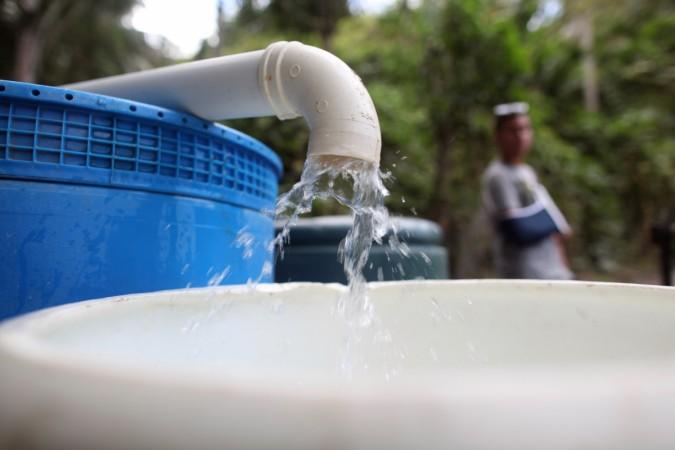
Bengaluru's water shortage is a topic that has grabbed intense focus over the years. Everyone agrees that rapid expansion of India's Silicon Valley has led to alarming depletion of water sources. Yet very little has been done over the years to address the basic problems.
The latest projections say Bengaluru will run out of groundwater by 2020 due to the fast pace of growth and urbanisation. However, the authorities are turning a blind eye to the core issues even as the 'Day Zero' is almost here.
A quick examination of the mess reveals that misplaced policy priorities have worsened the problem over the years. A conversation the International Business Times had with the Indian Institute of Science Professor TV Ramachandra reveals that governments have missed the bus when it comes to preventing the looming water crisis.
Professor TV Ramachandra, who is part of the Energy and Wetlands Research Group, was the first to warn that Bengaluru is likely to be the next Cape Town due to the water crisis. He reveals that the situation at hand is critical. As much as 81 percent of the 746 sq km area of Bengaluru is concretised currently. In comparison, during the 1970s, 68.7 percent of the city was covered in green. Between 1973 and 2017, concretised areas have increased 1,028 percent, while 88 percent of green cover and 79 percent of water bodies have been lost.
Government should take up cost-effective measures
While it's clear that rampant development has led to the depletion of water sources and the deterioration of the environment, what's more disturbing is the fact that the proposed solutions are not the right ones. According to Prof Ramachandra, Bengaluru receives 700-800 mm of rainfall but rainwater harvesting is not being implemented adequately. Nearly 15 TMC of water can be saved through rainwater harvesting, but instead of looking at these options governments have been chasing multi-crore projects like Mekedatu, Sharavati and Yetinahole.
The most efficient way to conserve water is to rejuvenate the lake and retain the rainwater. If the lakes in Bellandur and Varthur region are desilted 5.4 TMC of water can be stored in the region
The Mekedatu project in Ramanagara district aims to enhance the supply of drinking water to Bengaluru and recharge the groundwater table in the region. The project cost is around Rs 5,900 crore, according to the DPR. On top of it, nearly 52.5 sq km of forest land will be submerged if the controversial project goes ahead.
The objective of Sharavati project was to bring the river water to Bengaluru from Linganamakki reservoir in Shivamogga district. But according to studies, the water retention in the catchment has come down and the dam there is silted. To make it worse, people living downstream Sharavati did not have water during the summer, raising questions if it was feasible to transfer water to Bengaluru.
Yetinahole is a similar case and comes with a revised cost of Rs 13,000 crore. The authorities say it harnesses 24 TMC of water but in reality, only 9.85 TMC is available.
Prof Ramachandra tells IBT Media that rejuvenation of lakes and propagation of water harvesting are the more efficient ways to conserve water than implementing big-budget projects. However, even when many of these government projects are failing and public money is wasted, not many seem to be questioning the wrong policies.
"The most efficient way to conserve water is to rejuvenate the lake and retain the rainwater. If the lakes in Bellandur and Varthur region are desilted 5.4 TMC of water can be stored in the region. But the BDA has an objection against removing the silt as they said that only 20 per cent will be desilted," said Prof Ramachandra.
The BWSSB secondary treatment plant cannot remove the nutrients or heavy metals, in the inflow it shows the presence of these nutrients but in the outflow, it is zero
Corruption
The solution for burning civic issues mostly runs into bureaucratic and political corruption. Not just Bengaluru but 370 districts in the country are under drought. The mismanagement of water sources and unplanned urbanisation have taken people to the brink. Water for daily use is getting costlier every year and the tanker mafia is choking city dwellers. At the same time, the government is not looking at cost-effective measures but taking up multi-crore projects.
Desilting of lakes, watershed management, recycling and reusing of wastewater should be implemented widely by the government, according to experts.
Water contamination affecting health
Not just the quantum of water but the quality of it is also a problem in large urban areas. Vegetable and fish samples taken from lakebeds reveal a high level of contamination. "We took food samples from Bellandur area including fish, spinach and mint. All had the presence of heavy metal and it gets reflected in health in the form of cancer or kidney failure. The environmental literacy in Bengaluru is only 3.5 percent although we have educated people all around the city and the ecological degradation is linked to it," says Prof Ramachandra.

He also highlights the fact that the BBMP data on water quality is all but flawed. When asked about the water quality data shown on LED screens installed around the city, the expert pointed out that the data could be flawed. "The BWSSB secondary treatment plant cannot remove the nutrients or heavy metals, in the inflow it shows the presence of these nutrients but in the outflow, it is zero," he said.
Who will address Bengaluru's water woes? It's estimated that as much as 98.5 percent of the city landscape will be concretised by 2025. Will a solution be in place by then? Only if the government acts quickly and adopts the right strategies.











